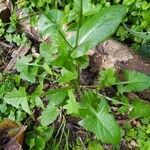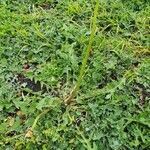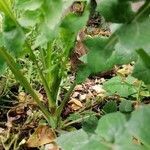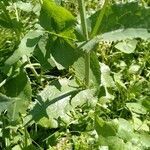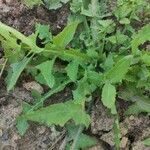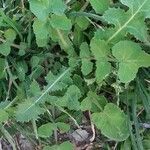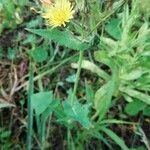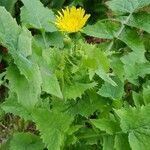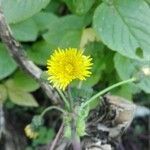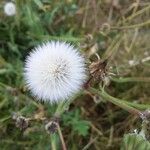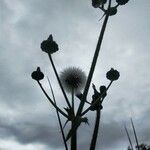Robust, short-lived herb to 1 ( ?-1.5) m tall; stems terete, striate, hollow; rootstock stout, sometimes branched; sap milky. Leaves mostly cauline, obovate to oblanceolate, to 30 cm long, mostly incised, denticulate, the apical segment truncate to hastate, apically obtuse or rounded, the basal portion often narrowed into a distinct, winged, mostly entire-margined petiole, expanded into denticulate, pointed auricles clasping the stem, the teeth callose-mucronate, glabrous. Inflores-cence an open panicle; peduncles with gland-tipped bristles; pedicels bracteate, mostly 1-3 cm long, glabrous. Heads showy, ligulate; involucre 10-20 mm tall, the bracts numerous in several, graded, imbricate series, narrow, herbaceous, glabrate or with a few bristles; florets all ligulate, all perfect, all fertile, the corollas yellow, the outermost series slightly exceeding the involucral bracts, yellow but sometimes dorsally reddish, the inner series slightly smaller, yellow, pilose at the base of the limb, glabrate above and below, apically mostly 5-denticulate, the anthers with yellow or darkened appendages, basally sagittate, the style apically ascending-pubescent, the branches narrow, puberulent. Achenes compressed lachrymiform, rugose with 2 fine sulci on each side, russet, the outermost achenes sometimes slightly thicker and lighter colored, beak wanting; pappus of numerous silky, persistent hairs and fewer, stouter, strigulose, deciduous bristles.
Annual. Roots tap and fibrous. Stem erect, simple or branched, finely grooved or ribbed, glabrous, 50-120 cm tall. Lvs soft, dull to ± shiny, mid to dark green to glaucous above, pale to glaucous beneath, glabrous, ± oblanceolate to obovate; margins dentate with spinulose teeth. Rosette and lower stem lvs (4)-10-20 × (1.5)-4-10 cm, pinnatifid almost to midrib; lobes reflexed or recurved, ovate to narrowly triangular; petiole narrowly winged. Upper lvs pinnatifid, usually with broadly triangular terminal lobe, 1-3 pairs of narrowly triangular lateral lobes, a broadly expanded winged petiole, and an amplexicaul-auriculate base with pointed lobes, sometimes lf not lobed, ovate-amplexicaul, rarely pinnatisect with linear lobes. Infl. cymose to umbellate; capitula few to many. Involucre 10-15 mm long, turbinate to cylindric; bracts imbricate, reflexed at fruiting, usually glabrous or rarely with a few pale glandular or eglandular setae. Receptacle glabrous. Florets 11/2× length of involucre; corolla tube c. = ligule; ligules spreading, yellow. Achenes narrowly obovoid to clavate, brown, weakly flattened, 2.5-3 × 0.8-1 mm, 3-ribbed on each face, not winged; ribs and spaces between finely transversely wrinkled. Pappus fine, white, c. = involucre.
Annual or biennial herb, 0.1–1.4 m high; stems (glaucous) green with reddish or purplish tinge, slightly succulent, hollow, stout and erect, simple or branched, ridged, glabrous or sometimes glandular-setose near the inflorescence.. Leaves dull green, often glaucous beneath, (ob-)lanceolate in outline, entire to pinnatilobed, 4–30 cm long, 1–9(–17) cm wide, base amplexicaul, auriculate with sagittate auricles, blade pinnatilobed to pinnatipartite, midrib narrowly winged and toothed, lobes few, reflexed, coarsely dentate, sometimes with spinulose teeth, the apical lobe ovate-hastate, apex rounded or acute, glabrous; distal leaves becoming smaller and less lobed to subentire.. Capitula few to many in lax leafy corymbs or panicles; involucre 10–13 mm long; phyllaries green with paler tips, lanceolate, 2.5–13 mm long, obtuse, glabrous but for the ciliate apex, or rarely glandular-setose on the midrib, the outer becoming swollen at base.. Florets many; corolla yellow, tube cylindric, 6–7.5 mm long, ligule 5.5–6 mm long.. Achenes (reddish)brown, narrowly obovoid, slightly flattened, 2.5–4 mm long, ribbed, minutely muricate; pappus white, 7–8 mm long.. Fig. 25.
Erect, annual herb, up to 1.5 m high, with milky latex. Stems hollow, reddish tinged, glabrous or sometimes densely glandular-setose, setae purplish. Leaves: lower leaves crowded, oblanceolate in outline, pinnately lobed to coarsely runcinate-pinnatipartite, with broad ovate-hastate apical lobe, rounded to acute at apex, margins coarsely and somewhat irregularly dentate, midrib narrowly winged, ± auriculate and semi-amplex-icaul, auricles ± sagittate-spreading, entire to dentate; upper leaves sessile, smaller, lanceolate, ± deeply lobed to subentire, margins coarsely and sharply dentate, basal auricles large with acute spreading lobes. Capitula ligulate, many in stalked, corymbi-form cymes, stalks glabrous or glandular-setose; involucral bracts in many rows, imbricate, bases of outer ones densely white-tomentose, soon glabrescent, sometimes with large glandular setae along midrib. Florets 5-lobed, yellow. Flowering time Aug.-Feb., May. Pappus of white, barbellate bristles intermixed with down-like hairs. Cypselae light to reddish brown, narrowly obovoid, slightly compressed, many ribbed, transversely wrinkled, minutely retrorsely hispid.
Annuals or biennials to c. 1.8 m high, with rosette variously developed. Leaves to c. 25 cm long, with l:w ratio commonly c. 2–10, divided or not, thin or slightly coriaceous, always ± pliant along margin; base above mid-stem strongly stem-clasping with auricles usually sagittate, sometimes slightly to strongly downturned, but not arching back toward apex; margin variably denticulate, with spiny tips 0.5–1 mm long, or entire, generally not prickly; divided leaves pinnatisect, occasionally almost bipinnatisect, with up to 5 spreading to retrorse primary lateral segments per side; terminal segment often much larger than lateral segments; uppermost leaves variously shaped. Capitula mostly several; involucre 8–13 mm long, 3–6 mm diam.; outer and intermediate bracts ovate to lanceolate. Florets: ligule 5–8 mm long, ± equal to tube; style hairs dark. Achenes oblanceolate, 2.2–3.2 mm long, 0.5–1 mm wide, moderately compressed, not obviously winged, transversely wrinkled, minutely scabridulous on margins; marginal achenes pale yellow and central ones reddish brown. Pappus 5–8 mm long.
Annual herb, up to 1.5 m high; with milky latex. Stems hollow, reddish tinged. Leaves crowded basally and along flowering stems; blade of lower leaves obovate in outline, 200 x 50 mm, pinnately lobed or coarsely runcinate-pinnatifid, with broad ovate-hastate apical lobe, apex rounded to acute, margins dentate, with petiole-like base; upper leaves runcinate-pinnatifid or coarsely and sharply dentate, base auriculate, auricles large, acute, sessile, amplexicaul. Heads ligulate, 15 x 10 mm, several in irregular, corymbose umbel, pedunculate. Involucral bracts in several series, imbricate, glabrous or glandular-hairy. Flowers: ligules pale yellow; Oct.-Jan., Jun. Fruit with cypsela light to reddish brown, narrowly obovate, attenuate towards base, slightly compressed, ribbed, transversely wrinkled, minutely retrorsely hispid, margins thickened, ± 3 mm long. Pappus of barbellate bristles intermixed with down-like hairs.
Annual 1–20 dm from a short taproot, glabrous except sometimes for a few spreading gland-tipped hairs on the invols and peduncles; lvs pinnatifid to occasionally merely toothed, soft, the margins only weakly or scarcely prickly, 6–30 × 1–15 cm, all but the lowermost ones prominently auriculate, the auricles well rounded but eventually sharply acute; lvs progressively less divided upward and ± reduced; heads several in a corymbiform infl, relatively small, 1.5–2.5 cm wide in fl; invol 9–13 mm in fr; fls 80–250 per head; cor-tube about equaling the ligule; achenes 2.5–3.5 mm, transversely rugulose and evidently to rather obscurely 3–5-ribbed on each face; 2n=32, 36. A cosmopolitan weed, native to Europe. July–Oct.
Lower leaves crowded, up to c. 28 x 9 cm., ± oblanceolate in outline, usually pinnately-lobed to coarsely runcinate-pinnatipartite, each with a broadly ovate-hastate apical lobe rounded to acute at the apex; margins usually coarsely and somewhat irregularly dentate with spinulose-acicular teeth; midrib narrowly winged, ± auriculate and semi-amplexicaul below; auricles ± sagittate-spreading, entire to dentate.
An erect annual hairy herb. It has milky sap. It is 40 to 60 cm high. The plant is bluish-green. The leaves are alternate. The leaves do not have stalks and half clasp the stem. Leaves are 10 to 20 cm long and very coarsely lobed. Flower heads are about 1 cm long and yellow. The fruit is dry and 3 ribbed. It opens to a round white ball. The seeds blow in the wind.
Phyllaries many-seriate imbricate increasing in length from c. 3 mm. on the outside to c. 13 mm. inside, narrowly lanceolate, glaucous, glabrous except for ciliate apicies and occasionally 1-several large glandular-setae up to c. 2 mm. long along the midrib, the midribs below becoming swollen and corky.
Stem up to c. 150 cm. tall, simple or sparsely branched in the upper half, leafy hollow usually reddish-tinged often glaucous, stem and branches glabrous or sometimes ± densely glandular-setose and somewhat viscid, setae up to c. 1 mm. long patent purplish; branches up to c. 45 cm. long ascending.
Erect annual, with hollow stems, up to 1.5 m tall. Leaves mostly in a basal tuft, runcinate-pinnatifid, toothed, with winged petiole, upper leaves clasping. Flowerheads in irregular, corymbose umbels at branch tips, with peduncles sometimes glandular-hairy, ligulate, pale yellow, ± 10 mm diam.
Capitula stalked, many in corymbiform cymes, stalks glabrous or glandular-setose; involucres up to c. 13 mm. long and 10 mm. in diam., very broadly cylindrical later spreading, densely white tomentose below soon glabrescent, involucre becoming swollen in fruiting capitula.
Annual herb, up to 1.5 m high. Involucral bracts glabrous or glandular-hairy. Achenes slightly compressed, transversely wrinkled, minutely retrorsely hispid, narrowly obovate, attenuate towards base, margins thickened. Flowers pale yellow.
Achenes light to reddish-brown, up to c. 3 x 1 mm., narrowly obovoid and somewhat flattened, ± uniformly many-ribbed; ribs minutely muricate with numerous retrorse projections.
Upper leaves sessile, smaller, lanceolate, ± deeply lobed to subentire, coarsely and sharply dentate on the margins, basal auricles usually large with acute spreading lobes.
Florets numerous; corollas yellow up to c. 13 mm. long, tube slender and pubescent above, ligule c. 5.5 mm. long and strap-shaped.
Pappus white copious c. 7 mm. long, composed of barbellate setae intermixed with down-like hairs.
All leaves ± spathulate at first, often deeply laciniate in depauperate specimens.
Occasionally with glular hairs on stems peduncles
A coarse erect annual herb 1-3 ft. high
A stout erect annual herb.
Florets yellow
A milky sap
A weed.
